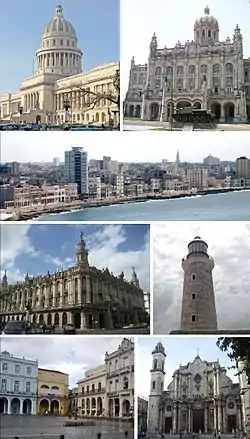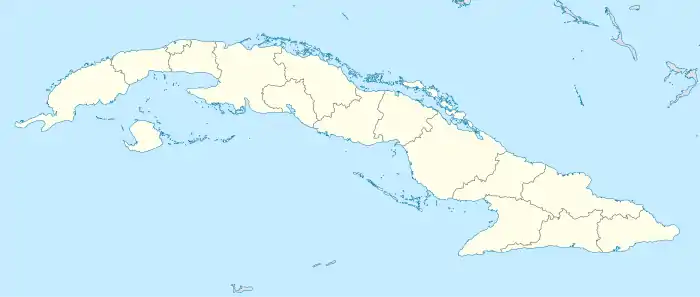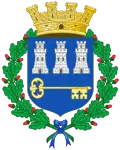哈瓦那
哈瓦那(西班牙語:[la aˈβana] (![]() 聆聽))[3],當地華人舊稱灣京或夏灣拿,为古巴的首都,主要城市以及商业中心。城市人口有240万人。是古巴和加勒比海国家里最大的城市。城市分别向西和向南延伸,内有三个港口:Regla、Guanabacoa和Atarés。阿尔门达雷斯河从南到北贯穿整个城市,注入佛罗里达海峡。它位于古巴的西北部海岸,被哈瓦那省包围,距离佛罗里达州的基韦斯特南部144千米。地理位置是北纬23度8分、西经82度23分。
聆聽))[3],當地華人舊稱灣京或夏灣拿,为古巴的首都,主要城市以及商业中心。城市人口有240万人。是古巴和加勒比海国家里最大的城市。城市分别向西和向南延伸,内有三个港口:Regla、Guanabacoa和Atarés。阿尔门达雷斯河从南到北贯穿整个城市,注入佛罗里达海峡。它位于古巴的西北部海岸,被哈瓦那省包围,距离佛罗里达州的基韦斯特南部144千米。地理位置是北纬23度8分、西经82度23分。
| 哈瓦那 La Habana | |||
|---|---|---|---|
| 首都 | |||
 | |||
| |||
| 綽號:万柱之城、加勒比海的罗马[1] | |||
 哈瓦那 在古巴的位置 | |||
| 坐标:23°08′12″N 82°21′32″W | |||
| 国家 | |||
| 省份 | 哈瓦那市 | ||
| 建立 | 1515年a | ||
| 立市 | 1592年 | ||
| 自治市 | 15个市 | ||
| 政府 | |||
| • 类型 | 市长议会制 | ||
| • 市长 | 马塔·埃尔南德斯 (古巴共产党) | ||
| 面积 | |||
| • 总计 | 728.26 平方公里 (281.18 平方英里) | ||
| 海拔 | 59 米(194 英尺) | ||
| 人口(2018年12月31日)[2] | |||
| • 總計 | 2,131,480人 | ||
| • 密度 | 2,892.0人/平方公里(7,490人/平方英里) | ||
| 时区 | UTC−05:00(UTC-5) | ||
| • 夏时制 | UTC−04:00(UTC-4) | ||
| 邮政编码 | 10xxx–19xxx | ||
| 電話區號 | (+53) 07 | ||
| 主保圣人 | 圣克里斯多福 | ||
| a于1519年于现地点建立。 | |||
需要注意的是,哈瓦那市(Ciudad de La Habana)并不属于前哈瓦那省,而是单独成为古巴15个省份之一,名称就是哈瓦那市(Ciudad de La Habana),哈瓦那市下分为15个(县)区(municipio)。在古巴及大部分拉美国家,municipio是基层地方政府。此外,哈瓦那(La Habana)一词在当地人的口中一般特指该城于西班牙殖民时期所建的部分,即哈瓦那旧城(La Habana Vieja)以及后来建造的中哈瓦那(Centro Habana)。
西班牙腓力二世国王于1592年授予哈瓦那城市的封号,并于1634年由皇家頒佈其"通往新世界的钥匙和西印度群岛的堡垒"封号以正式确认该市的重要地位。[4]这个封号铭刻在哈瓦那的盾章上。西班牙人开始修建防御工事,在1553年政府所在地从岛上最东面的圣地亚哥迁到了哈瓦那,从而使哈瓦那成为实际意义上的首都(de facto capital)。修建港口防御工事的重要性最早是由于当时英国、法国以及荷兰的海盗在16世纪袭击该城市。而在1898年,美国緬因號戰艦在哈瓦那港口沉船事件是美西战争的导火索。
历史
哈瓦那在1607年成为当时属西班牙殖民地的古巴的首都,是西班牙在新世界殖民地里的重要港口。1762年,英国在七年战争中夺取哈瓦那,实行港口自由贸易,引进大量非洲奴隶。战后,英国和西班牙对换古巴与佛罗里达。哈瓦那又归西班牙管制。
气候
| 哈瓦那(1961–1990, 极端数据1859–现在)气候平均数据 | |||||||||||||
|---|---|---|---|---|---|---|---|---|---|---|---|---|---|
| 月份 | 1月 | 2月 | 3月 | 4月 | 5月 | 6月 | 7月 | 8月 | 9月 | 10月 | 11月 | 12月 | 全年 |
| 历史最高温℃(℉) | 32.4 (90.3) |
33.0 (91.4) |
35.3 (95.5) |
37.0 (98.6) |
36.2 (97.2) |
35.4 (95.7) |
36.6 (97.9) |
37.7 (99.9) |
38.2 (100.8) |
39.6 (103.3) |
34.0 (93.2) |
33.2 (91.8) |
39.6 (103.3) |
| 平均高温℃(℉) | 25.8 (78.4) |
26.1 (79) |
27.6 (81.7) |
28.6 (83.5) |
29.8 (85.6) |
30.5 (86.9) |
31.3 (88.3) |
31.6 (88.9) |
31.0 (87.8) |
29.2 (84.6) |
27.7 (81.9) |
26.5 (79.7) |
28.8 (83.8) |
| 每日平均气温℃(℉) | 22.2 (72) |
22.4 (72.3) |
23.7 (74.7) |
24.8 (76.6) |
26.1 (79) |
27.0 (80.6) |
27.6 (81.7) |
27.9 (82.2) |
27.4 (81.3) |
26.1 (79) |
24.5 (76.1) |
23.0 (73.4) |
25.2 (77.4) |
| 平均低温℃(℉) | 18.6 (65.5) |
18.6 (65.5) |
19.7 (67.5) |
20.9 (69.6) |
22.4 (72.3) |
23.4 (74.1) |
23.8 (74.8) |
24.1 (75.4) |
23.8 (74.8) |
23.0 (73.4) |
21.3 (70.3) |
19.5 (67.1) |
21.6 (70.9) |
| 历史最低温℃(℉) | 6.0 (42.8) |
11.9 (53.4) |
10.0 (50) |
15.1 (59.2) |
15.4 (59.7) |
20.0 (68) |
19.0 (66.2) |
20.0 (68) |
20.0 (68) |
18.0 (64.4) |
14.0 (57.2) |
10.0 (50) |
6.0 (42.8) |
| 平均降雨量㎜(英寸) | 64.4 (2.535) |
68.6 (2.701) |
46.2 (1.819) |
53.7 (2.114) |
98.0 (3.858) |
182.3 (7.177) |
105.6 (4.157) |
99.6 (3.921) |
144.4 (5.685) |
180.5 (7.106) |
88.3 (3.476) |
57.6 (2.268) |
1,189.2 (46.817) |
| 平均降雨日数(≥ 1.0 mm) | 5 | 5 | 3 | 3 | 6 | 10 | 7 | 9 | 10 | 11 | 6 | 5 | 80 |
| 平均相对湿度(%) | 75 | 74 | 73 | 72 | 75 | 77 | 78 | 78 | 79 | 80 | 77 | 75 | 76.1 |
| 每月平均日照时数 | 217.0 | 203.4 | 272.8 | 273.0 | 260.4 | 237.0 | 272.8 | 260.4 | 225.0 | 195.3 | 219.0 | 195.3 | 2,831.4 |
| 每日平均日照时数 | 7.0 | 7.2 | 8.8 | 9.1 | 8.4 | 7.9 | 8.8 | 8.4 | 7.5 | 6.3 | 7.3 | 6.3 | 7.8 |
| 来源 #1:世界气象组织,[5] Climate-Charts.com[6] | |||||||||||||
| 来源 #2:Meteo Climat (极高、极低值记录),[7] 德国气象局 (日照)[8] | |||||||||||||
友好城市
参考资料
从维基百科的姊妹计划 了解更多有关 “Havana”的内容 | |
| 维基词典上的字词解释 | |
| 维基共享资源上的多媒体资源 | |
| 维基新闻上的新闻 | |
| 维基语录上的名言 | |
| 维基文库上的原始文献 | |
| 维基教科书上的教科书和手册 | |
| 维基学院上的學習资源 | |
備註
- . Lonely Planet. [10 January 2015]. (原始内容存档于2015年1月10日).
- (PDF). [2020-05-19]. (原始内容 (PDF)存档于2020-06-11).
- 大陸及台灣稱;粵語人士稱
- (英文) Capital city Archive.is的存檔,存档日期2012-06-04 - capital of Spanish Cuba in 1552
- . Cuban Institute of Meteorology. June 2011 [June 26, 2010]. (原始内容存档于2019-01-07).
- . [June 26, 2010]. (原始内容存档于2011-06-23). 已忽略未知参数
|url-status=(帮助) - . Meteo Climat. [May 2, 2017] (法语).
- (PDF). Baseline climate means (1961–1990) from stations all over the world. Deutscher Wetterdienst. [July 29, 2017]. (原始内容存档 (PDF)于2019-05-10) (德语).
來源
- King, Charles Spencer (2009) Havana My Kind of Town. USA: CreateSpace. ISBN 1-4404-3269-4.
- Havana: History and Architecture of a Romantic City. Alicia García Santana. Monacelli, October 2000. ISBN 1-58093-052-2.
- The Rough Guide to Cuba (3rd ed.). Rough Guides, May 2005. ISBN 1-84353-409-6.
- Barclay, Juliet (1993). Havana: Portrait of a City. London: Cassell. ISBN 1-84403-127-6 (2003 paperback edition). — A comprehensive account of the history of Havana from the early 16th century to the end of the 19th century.
- Carpentier, Alejo. La ciudad de las columnas (The city of columns). — A historical review of the city from one of the major authors in the iberoamerican literature, a native of this city.
- Cluster, Dick, & Rafael Hernández, History of Havana. New York: Palgrave-MacMillan, 2006. ISBN 1-4039-7107-2. A social history of the city from 1519 to the present, co-authored by a Cuban writer and editor resident in Havana and an American novelist and writer of popular history.
- Eguren, Gustavo. La fidelísima Habana (The very faithful Havana). — A fundamental illustrated book for those who wants to know the history of La Habana, includes chronicles, articles from natives and non natives, archives documents, and more.
- United Railways of Havana. Cuba: A Winter Paradise. 1908-1909, 1912-1913, 1914-1915 and 1915–1916 editions. New York, 1908, 1912, 1914 and 1915. Maps, photos and descriptions of suburban and interurban electric lines.
- Electric Traction in Cuba. Tramway & Railway World (London), 1 April 1909, pp. 243–244. Map, photos and description of Havana Central Railroad.
- The Havana Central Railroad. Electrical World (New York), 15 April 1909, pp. 911–912. Text, 4 photos.
- Three-Car Storage Battery Train. Electric Railway Journal (New York), 28 September 1912, p. 501. Photo and description of Cuban battery cars.
- Berta Alfonso Gallol. Los Transportes Habaneros. Estudios Históricos. La Habana, 1991. The definitive survey (but no pictures or maps).
- Six Days in Havana by James A. Michener and John Kings. University of Texas Press; 1ST edition (1989). ISBN 978-0-292-77629-6. Interviews with close to 200 Cubans of widely assorted backgrounds and positions, and concerns how the country has progressed after 90 years of independence from Spain and under the 30-year leadership of Castro.
- One more interesting note about that edition of the New York Times: On page 5, there is a short blurb mentioning, "The plan for holding a Pan-American exhibition at Buffalo has been shelved for the present owing to the unsettled condition of the public mind consequent upon the Spanish-Cuban complications." President McKinley was assassinated at the Pan-American Exhibition when it was finally held in 1901.
外部链接
- Russian Havana on CubaWorld页面存档备份,存于
- Central Havana Map页面存档备份,存于
- Havana City Map页面存档备份,存于
- Havana Travel Q & A页面存档备份,存于
 维基导游中有關哈瓦那的旅遊指南
维基导游中有關哈瓦那的旅遊指南- Map of Havana. To zoom in, click on an area of the map. These are very large High resolution JPEG images (~1 Megabyte)
- Wikia有關於這個主題的wiki在Havana
- Fading Grandeur and Teeming Night Life Make Havana Hard to Resist by Victor Swoboda, CanWest, November 10, 2008
- Searching for Cuba's Next Big Revolution页面存档备份,存于 by Spud Hilton, San Francisco Chronicle, April 19, 2009


